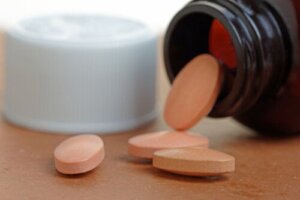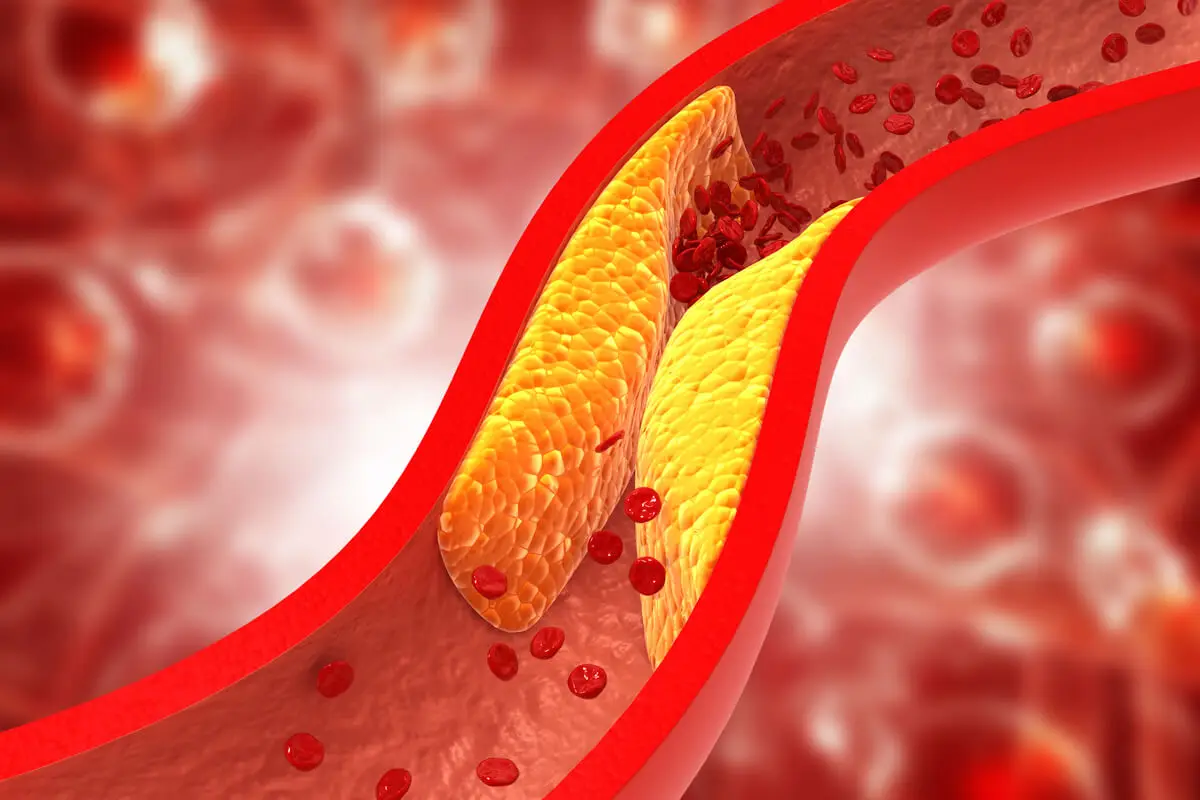All the Benefits and Risks of Statins


Written and verified by the doctor Mariel Mendoza
Statins are useful in lowering cholesterol and in the prevention of cardiovascular disease. This is, above all, acute myocardial infarction and cerebrovascular disease.
They are indicated in patients with blood low-density lipoprotein (LDL) cholesterol greater than or equal to 115 mg/dL or total cholesterol greater than or equal to 200 mg/dL, with high cardiovascular disease risk, or as treatment of established cardiovascular disease. Although they’re considered effective and safe, they have been associated with adverse reactions in a limited number of cases.
How do statins work?
Statins inhibit the critical step in hepatic cholesterol synthesis: conversion to mevalonate. Cholesterol is a lipid produced in the liver that has multiple functions in the body, such as a precursor of hormones and a component of cell membranes.
By blocking its synthesis, circulating cholesterol in the blood must be used, which reduces the blood concentration. In addition, the mevalonate pathway influences endothelial function, inflammatory response, and coagulation. Thus, the effects of statins are considered to go beyond lowering blood cholesterol.
Statins include the following:
- Atorvastatin
- Fluvastatin
- Lovastatin
- Pitavastatin
- Pravastatin
- Rosuvastatin
- Simvastatin
High cholesterol levels are associated with the formation of atheroma plaques (atherosclerosis) in blood vessels. This condition blocks blood flow, decreasing oxygen delivery to tissues.
We think you may also enjoy reading this article: Policosanol: Is it Effective in Regulating Cholesterol and Blood Pressure?
The benefits of statins
As we made clear, science has found that statins have effects beyond circulating cholesterol. Therefore, they are considered much more than lipid-lowering drugs.
The help reduce cholesterol
The minimum effective doses of the different statins achieve a 20-50% reduction in LDL cholesterol concentration. They’re used after a stroke or myocardial infarction to reduce the risk of another episode. Also, statins are used when there are high blood cholesterol levels associated with an increased risk of cerebrovascular disease (as primary prevention).

They have pleiotropic effects
The process of atherosclerosis involves not only high cholesterol concentrations, but also endothelial dysfunction, persistent inflammation, and clot formation. Statins inhibit the formation of mevalonate products that modulate the different mechanisms of atherosclerosis.
They can improve endothelial function
Endothelial dysfunction is one of the main factors associated with atherosclerosis and is exacerbated by multiple situations, such as the following:
- Diabetes
- Obesity
- Smoking
- High cholesterol
- High blood pressure
Statins promote blood vessel dilation, secondary to increased nitric oxide. Thus, they become a protective factor.
They have anti-inflammatory effects
Statins decrease the production of proinflammatory factors, such as C-reactive protein and certain forms of interleukins. The effect decreases the adhesion of molecules associated with cardiovascular disease.
Statins have a cardioprotective function
Statins stabilize existing atheroma plaques, preventing them from increasing in volume by incorporating more cholesterol. Oxidation of the substance is reduced, and the risk of a plaque accident is reduced.
They have an antithrombotic effect
In the case of atherosclerosis, after there’s endothelial dysfunction and inflammation, thrombi form and impede blood flow. Statins affect thrombus production by reducing platelet aggregation factor expression, decreasing thrombin synthesis, and the expression of its receptor on the platelet surface.
In addition, the activity of different procoagulant factors (fibrinogen and factors V, VII, and XIII) is reduced with treatment.
The risks of statins
Despite being considered safe, up to 0.5-1% of patients present adverse effects. The most frequent is muscle damage and neurological disorders.
Liver disease
Generally, statins only show an increase in the level of liver enzymes (transaminases), which indicates liver inflammation. Associated symptoms such as fatigue or weakness, loss of appetite, pain in the upper abdomen, dark-colored urine, and yellowish skin or eyes may also occur.
These cases are associated with people with previous liver disease that sometimes goes unnoticed at the time of drug indication. For this reason, it’s recommended that a transaminase control be performed before and during your treatment with statins.
Muscle damage
Muscle damage from statins is manifested by pain, weakness, and spasms. This can be mild discomfort or severe enough to make daily activities difficult.
Rarely, muscle damage can be severe and cause rhabdomyolysis. This situation manifests in severe muscle pain, liver damage, and even kidney failure. The condition has been linked to pre-existing risk factors or a combination with certain medications.
Diabetes
Statins are associated with increased blood glucose levels (blood glucose), which can lead to the development of type 2 diabetes mellitus. The risk is small, but the U.S. Food and Drug Administration (FDA) has issued a warning on labels.
This adverse effect is associated with people who previously had higher than normal blood glucose levels. That is why the use of the drug requires frequent monitoring.
Like this article? You may also like to read: Does Cocoa Help Lower Cholesterol? This Is What Science Says
Neurological conditions
From a neurological standpoint, statins can cause memory loss, confusion, or insomnia. These are symptoms that reverse once the drug is stopped.

The pros and cons of statins should be considered
In case of high blood cholesterol levels, a balance should be made between the benefits and risks of statins. Sometimes, changes in diet and lifestyle habits are effective in lowering lipid levels.
Statins lower blood cholesterol concentrations, reducing the risk of high blood pressure, cerebrovascular disease, myocardial infarction, and other conditions. On the other hand, their adverse effects are uncommon (less than 1%), and most people tolerate them well.
It’s recommended that, in the presence of any adverse effect, the dose should not be reduced without first consulting a physician. The presence of undesirable reactions to statins is associated with previous risk factors, such as low muscle mass, hypothyroidism, vitamin D deficiency, alcohol consumption, azole antifungals, or tricyclic antidepressants. Eliminating or reducing risk factors may help to reduce adverse effects.
All cited sources were thoroughly reviewed by our team to ensure their quality, reliability, currency, and validity. The bibliography of this article was considered reliable and of academic or scientific accuracy.
- Gobierno de Nueva Zelanda. The pros and cons of taking statins. MedSafe S.F. Disponible en https://www.medsafe.govt.nz/consumers/educational-material/Pros%20and%20Cons%20of%20Statins.pdf.
- Maiques A, Franch M, Fluixá C. Estatinas: eficacia, seguridad e indicaciones. Información Terapéutica del Sistema Nacional de Salud 2004;28(4). Disponible en https://www.sanidad.gob.es/biblioPublic/publicaciones/docs/vol28_4estatinas.pdf
- Mostaza J, et al. Uso de las estatinas en prevención primaria. IT del Sistema Nacional de Salud 2011;35. Disponible en https://www.sanidad.gob.es/biblioPublic/publicaciones/recursos_propios/infMedic/docs/vol35_2_Estatinas.pdf.
- Pinal I, Casal M, Mammen A. Statins: prons and cons. Med Clinc (Barc) 2017. Disponible en https://www.ncbi.nlm.nih.gov/pmc/articles/PMC6019636/.
- Thompson P, et al. Statin-Associated Side Effects. J Am Coll Cardiol 2016;67(20). Disponible en https://www.jacc.org/doi/full/10.1016/j.jacc.2016.02.071.
This text is provided for informational purposes only and does not replace consultation with a professional. If in doubt, consult your specialist.








